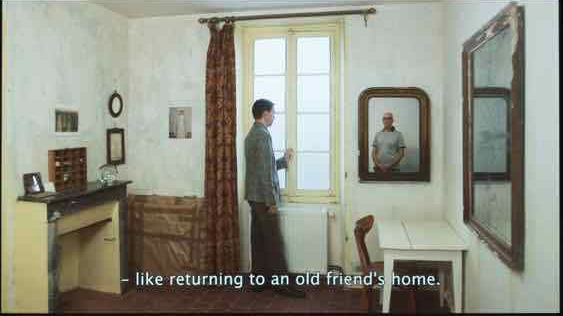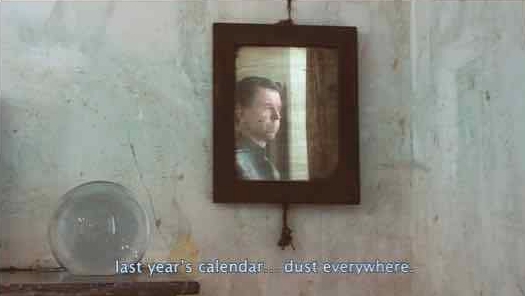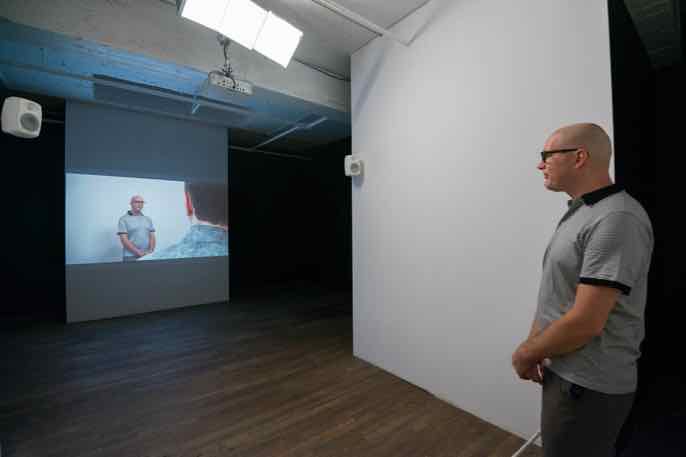Disorientation brings together the video and video-interactive works On Disappearance (2012) and Transit (2013) by the Finnish artist Lauri Astala.
Disorientation and Orientation
Throughout his carrier, Astala has explored our relationship to space. Initially, he examined scientific conventions of representing the world, particularly cartography, through sculpture. After completing graduate studies at the University of Chicago, the artist turned to video and interactive video installation. The works in this exhibition represent this form of expression.
The first room features the monumental work Transit, which is based on the futurist imaginary of film. In this long tracking shot, taken from the aerial tramway connecting Roosevelt Island to Manhattan, the camera movements, unusual framing decisions, and extensive visual and sound editing transform the American megalopolis into a sci-fi spaceship.
The experience of New York becomes inseparable from a phantasmagoria that is even more evocative than the city’s identity. The cinematic effect proves to be stronger than its familiar and recognizable character that is in fact often featured in films. The film reference acts like a veil making the identification and perception of the place more complex, just like the fog that blurs the landscape in the artist’s videos Gamelan (2010) and Rome Dérive II (2006). The work reveals culture’s effective contribution to our understanding of everyday surroundings, which are then made entirely imaginary through the unusual reframing.
The soundtrack, composed of mechanical and electronic sounds, clips from NASA communications, taxi dispatchers and radio broadcasts, and the sound of the tram itself, creates an environment that makes the place seem simultaneously familiar and strange. Thus the experience of the city corresponds to the experience of a site of communication that partly forms its identity.
A second room, which has been adapted to reproduce the initial shooting location of the work, features On Disappearance, a computer-aided video installation that engages viewers in real time. In a specific area of the exhibition space, a camera records viewers’ reactions as they watch the video. The recorded image is then integrated into the projection, particularly in the mirrors inside the room where the action is unfolding, thus merging the fictional space with the real one of the audience.
The character’s off-camera voice first describes the estrangement he feels towards this place he has returned to after some time, since the routines that had made it familiar have been interrupted. In this respect, the frame of the image gradually shifts so as to slowly give us the character’s perspective on the objects around him. The narration describes the repetitive gestures and habits that help to transform an anonymous space into a specific place, as well as the constant return to this familiar place that serves as a point of reference. The work suggests that daily gestural language and mobility are elemental to how one understands and identifies with a space.
The protagonist then turns his gaze towards the viewers and addresses them directly, changing the roles established so far. This reversal of the situation creates unease and makes us simultaneously confront the fictional and real experience of our position and role as viewers. The remarks of the character addressing us emphasize the discrepancies in the space and time demanding our attention, as well as a sense of identification and the underlying emotions.
The apparatus producing this unusual outcome also highlights a virtual co-presence related to technology. In this respect, Astala explores the technical modes of proximity, creating a bridge between two distinct living spaces. This experience, which is increasingly common, particularly for members of diasporas, presents a place as a dynamic and porous node of communication, a far cry from the territory that cartography seeks to circumscribe. Today, the perception of space and territory likewise appears to be modulated by this complexity.
Translated from french by Oana Avasilichioaei.
According to the text of the booklet published by Oboro during the exhibition Lauri Astala, Disorientations, from September 10 to October 15, 2016.






